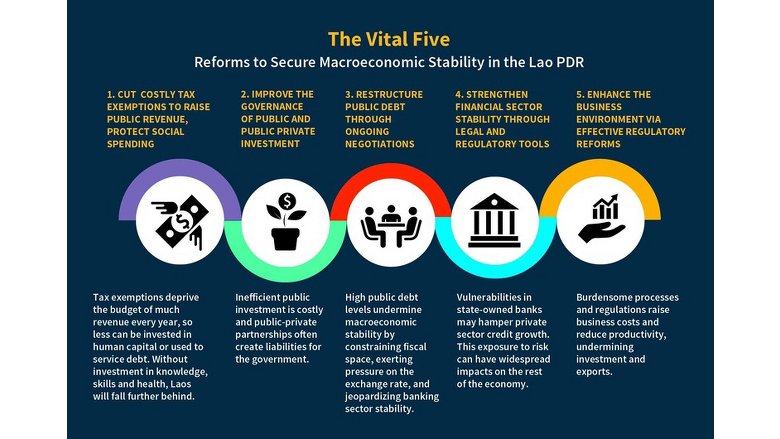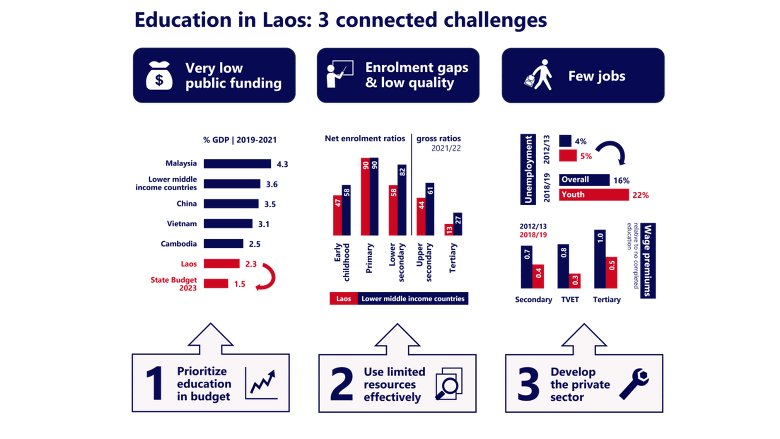Economic growth remains below 2019 levels, mainly owing to protracted macroeconomic instability. GDP growth over 2023 was an estimated 3.7%, with positive contributions from the services sector, mainly tourism, transport, logistics, and mining. High inflation caused by depreciation of the kip means that about a third of households, especially low-income families, have reduced their spending on health and education. In 2024, real GDP is projected to grow by 4%, constrained by structural challenges. Economic activity is expected to benefit from recovery in tourism, transport and logistics, and investment in the power sector and some special economic zones. Growth will remain below 2010-2019 levels, however, weighed down by macroeconomic instability, low human capital, out-migration, and a challenging business environment.
ˇ¤ Depreciation and high inflation persist amid limited foreign exchange liquidity and high external debt service obligations. In 2023, the annual average official kip/US dollar exchange rate weakened by 31%. Given LaosˇŻ high import dependence, depreciation brings changes in domestic prices. Headline inflation averaged 31% over 2023 and remains high, with food, transport, hotel, and restaurant price increases the main contributors.
ˇ¤ Foreign investment increased substantially in 2023, mainly in the electricity and mining sectors. In contrast, consumption remains constrained by high inflation. Merchandise export growth is limited, affected by labor shortages and subdued external demand. Electricity sales in 2023 were tempered by low rainfall.
ˇ¤ Average household incomes improved in 2023, but more than a third of families saw their nominal income growth lag behind inflation, implying a loss of purchasing power. High food inflation has undermined food security, particularly among urban families.
ˇ¤ The labor market is changing in response to economic conditions, with more workers moving abroad. The number of registered Lao migrants in Thailand rose by 15% between June 2023 and February 2024. Inside Laos, people are switching from service jobs to agriculture and manufacturing. Workers are also shifting from wage jobs and unpaid family work to self-employment and family businesses. Labor shortages have appeared in some sectors.
ˇ¤ Improved revenue collection has offset increased public spending but, due to interest payments on debt, the overall fiscal balance is estimated at a deficit of 0.2%. Public and publicly guaranteed debt is estimated to have remained above 110% of GDP in 2023, largely reflecting the kipˇŻs depreciation. Deferrals of principal and interest on debts owed to China amounted to about $2 billion (about 15% of GDP at the 2023 rate) between 2020 and 2023. Nevertheless, residual interest and principal payments on debt were still worth 5% of GDP. Access to international capital markets has deteriorated with the loss of access to the Thai bond market in September 2023. The government now relies more on domestic financing sources.
ˇ¤ Official balance of payments data show net foreign exchange inflows of about $250 million in the first three quarters of 2023, supported by large investment inflows. Recent moves to implement repatriation and conversion of export proceeds from mining, power, agriculture, and service sectors may bring more foreign currency into the economy in the short-run but could be counter-productive if they deter future investment or lead to misreporting.
ˇ¤ In 2024, real GDP is projected to grow by 4%, constrained by structural challenges. Economic activity is expected to benefit from recovery in tourism, transport and logistics, and investment in the power sector and some special economic zones. Despite the slight uptick this year, growth will remain below pre-COVID levels, weighed down by macroeconomic instability and structural constraints such as low human capital, labor shortages, and a challenging business environment.
ˇ¤ Reflecting persistent depreciation pressures, inflation is expected to remain above 20%, continuing to exert pressure on real incomes. This will affect household real incomes and restrain progress on poverty reduction.
ˇ¤ Restoring macroeconomic stability requires a strong commitment to five critical reform areas: (i) implementing the restored VAT rate of 10%, curbing tax exemptions, and reforming excise taxes, to boost spending on social sectors; (ii) expediting ongoing debt renegotiations and strengthening public debt management; (iii) managing risks from contingent liabilities related to state-owned enterprises and public-private partnerships; (iv) strengthening financial sector stability; and (v) improving the business environment to promote investment and exports. In addition, improving the availability, timeliness, and quality of data is essential for informing evidence-based policy making.




